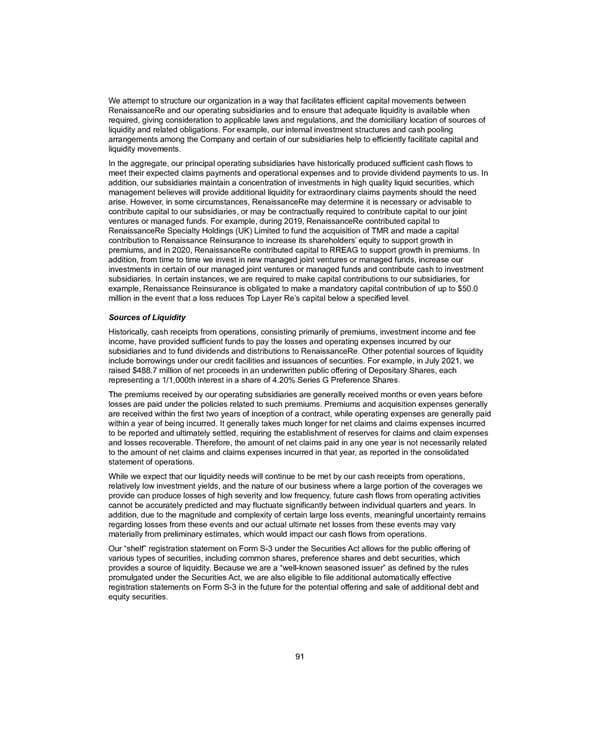We attempt to structure our organization in a way that facilitates efficient capital movements between RenaissanceRe and our operating subsidiaries and to ensure that adequate liquidity is available when required, giving consideration to applicable laws and regulations, and the domiciliary location of sources of liquidity and related obligations. For example, our internal investment structures and cash pooling arrangements among the Company and certain of our subsidiaries help to efficiently facilitate capital and liquidity movements. In the aggregate, our principal operating subsidiaries have historically produced sufficient cash flows to meet their expected claims payments and operational expenses and to provide dividend payments to us. In addition, our subsidiaries maintain a concentration of investments in high quality liquid securities, which management believes will provide additional liquidity for extraordinary claims payments should the need arise. However, in some circumstances, RenaissanceRe may determine it is necessary or advisable to contribute capital to our subsidiaries, or may be contractually required to contribute capital to our joint ventures or managed funds. For example, during 2019, RenaissanceRe contributed capital to RenaissanceRe Specialty Holdings (UK) Limited to fund the acquisition of TMR and made a capital contribution to Renaissance Reinsurance to increase its shareholders’ equity to support growth in premiums, and in 2020, RenaissanceRe contributed capital to RREAG to support growth in premiums. In addition, from time to time we invest in new managed joint ventures or managed funds, increase our investments in certain of our managed joint ventures or managed funds and contribute cash to investment subsidiaries. In certain instances, we are required to make capital contributions to our subsidiaries, for example, Renaissance Reinsurance is obligated to make a mandatory capital contribution of up to $50.0 million in the event that a loss reduces Top Layer Re’s capital below a specified level. Sources of Liquidity Historically, cash receipts from operations, consisting primarily of premiums, investment income and fee income, have provided sufficient funds to pay the losses and operating expenses incurred by our subsidiaries and to fund dividends and distributions to RenaissanceRe. Other potential sources of liquidity include borrowings under our credit facilities and issuances of securities. For example, in July 2021, we raised $488.7 million of net proceeds in an underwritten public offering of Depositary Shares, each representing a 1/1,000th interest in a share of 4.20% Series G Preference Shares. The premiums received by our operating subsidiaries are generally received months or even years before losses are paid under the policies related to such premiums. Premiums and acquisition expenses generally are received within the first two years of inception of a contract, while operating expenses are generally paid within a year of being incurred. It generally takes much longer for net claims and claims expenses incurred to be reported and ultimately settled, requiring the establishment of reserves for claims and claim expenses and losses recoverable. Therefore, the amount of net claims paid in any one year is not necessarily related to the amount of net claims and claims expenses incurred in that year, as reported in the consolidated statement of operations. While we expect that our liquidity needs will continue to be met by our cash receipts from operations, relatively low investment yields, and the nature of our business where a large portion of the coverages we provide can produce losses of high severity and low frequency, future cash flows from operating activities cannot be accurately predicted and may fluctuate significantly between individual quarters and years. In addition, due to the magnitude and complexity of certain large loss events, meaningful uncertainty remains regarding losses from these events and our actual ultimate net losses from these events may vary materially from preliminary estimates, which would impact our cash flows from operations. Our “shelf” registration statement on Form S-3 under the Securities Act allows for the public offering of various types of securities, including common shares, preference shares and debt securities, which provides a source of liquidity. Because we are a “well-known seasoned issuer” as defined by the rules promulgated under the Securities Act, we are also eligible to file additional automatically effective registration statements on Form S-3 in the future for the potential offering and sale of additional debt and equity securities. 91
 2021 Annual Report Page 106 Page 108
2021 Annual Report Page 106 Page 108